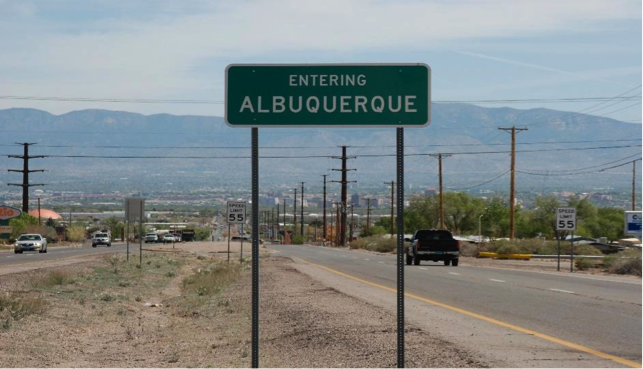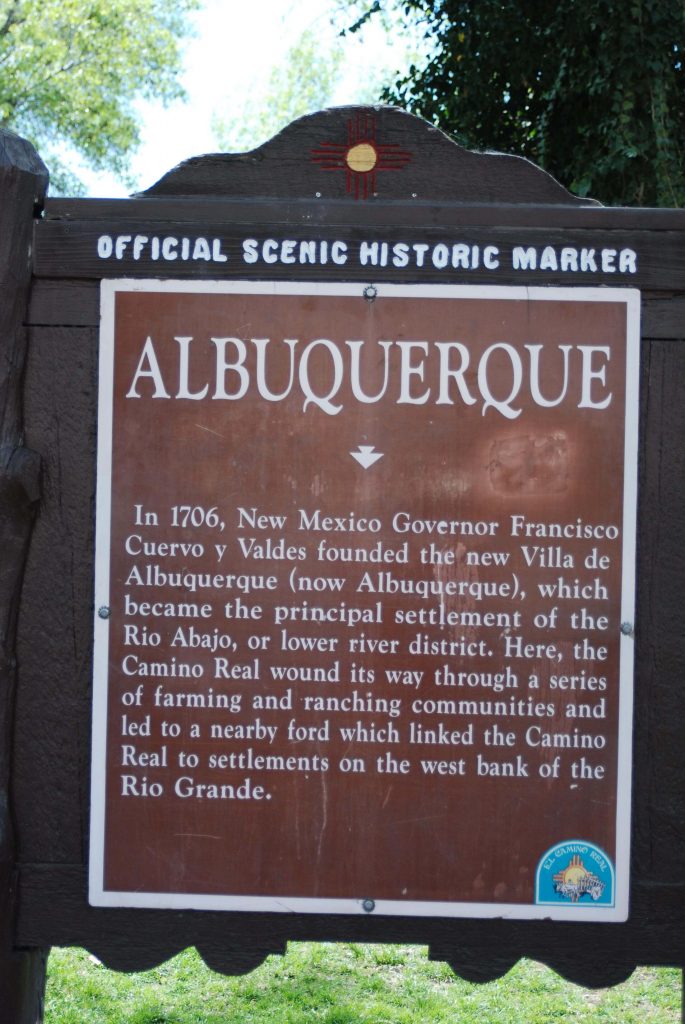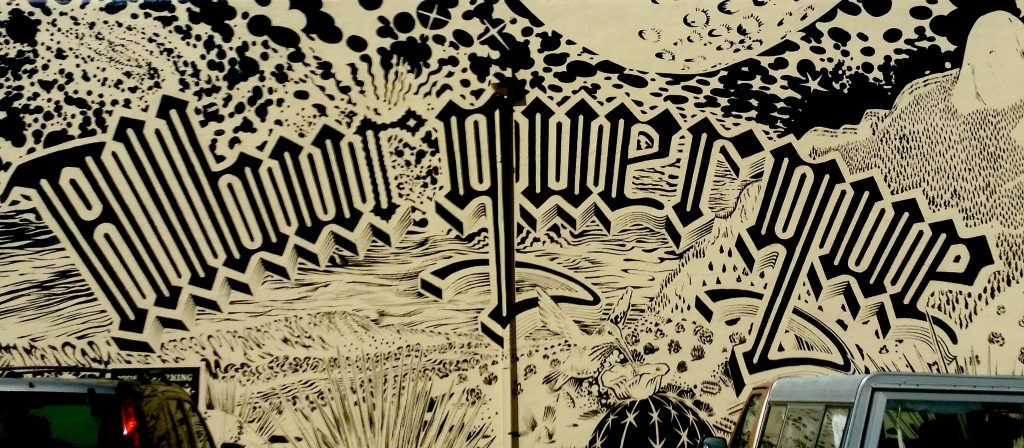[vc_row][vc_column width=”1/1″][text_output]
ANSWERED QUESTION
‘Alburquerque’ history a complicated cultural tale
As part of our Curious New Mexico project, Clara Johnson asked “I’d like to know about the origins of Albuquerque’s name and the early history of the city in general.” A team of News Port students found that the city’s cultural heritage remains hugely relevant to its contemporary life.

From its controversial founding in 1706, to a subtle name change, to its place on America’s fabled Route 66 — Albuquerque today is among the most culturally rich and diverse cities in the United States.
“Albuquerque is a place where you encounter ancient civilization of the pueblos, hispanic culture that reaches over 300 years,” said Robert Martinez, New Mexico assistant state historian. “It’s historical, scientific, technological and cultural. It has everything.”
The first residents
Albuquerque celebrated its Tricentennial in 2006, but its roots run deeper than three centuries.
Albuquerque’s history dates back 12,000 years when the ancient Puebloan Indians settled the area.
“We have to acknowledge that Native Americans were in the area first,” Martinez said.
The region surrounding present-day Albuquerque was home to several groups of Native Americans and was inhabited by the ancient Anasazi indians. Their huge apartment-like buildings, constructed 3,000 years ago of stone and adobe, are still standing throughout the state. The city continues to be a center of Native American culture: most of New Mexico’s 19 pueblos—including the thousand-year-old, still-inhabited Acoma Pueblo—are within an hour’s drive.
The “Duke City”
In 1540, Conquistador Francisco Vasquez de Coronado came to the area in search of the mythical Seven Cities of Cibola. Coronado’s interest in the area brought more Spanish settlers who established trading posts.
To impress the Spanish government, Don Francisco Cuervo y Valdes, the governor of the territory, petitioned to establish a settlement as a formal villa and call it Alburquerque, after Viceroy Francisco Fernandez de la Cuervo, the eighth Duque De Alburquerque of Spain. The name Alburquerque is a sign of royalty in Spain. From there, the first structure was built, a church named for the city’s patron saint, San Felipe de Neri. The church is still standing in Old Town.
“For the name, at first it was Villa de San Francisco Javier de Alburquerque,” said Joseph Sanchez, director of the UNM Spanish Colonial Research Center. “The name was changed to honor the king of Spain, King Philip the Fifth, which led to San Felipe de Rey Alburquerque.”
A controversial founding

“You had to have a minimum of 35 families to have founded a town,” Martinez said. “What’s controversial about the founding of Albuquerque is that we’re not sure if Cuervo y Valdes had the requisite of 35 families.”
No official document on the founding has been discovered. Although, many historians believe there were close to 200 families residing in the area.
“In the end it didn’t matter because the officials argue that the town was already established so let’s leave it at that,” Sanchez said.
After the city’s founding a number of events transpired. The Spanish and Native Americans battled in the late 1600’s. Later, the region was a property of Mexico. After a war between Mexico and the United States, Albuquerque and the surrounding land ended up in the hands of the United State government. The New Mexico territory was established by the government in 1850. Fast forward to Jan. 6, 1912, when New Mexico was founded as the 47th state.
‘Tri-cultural myth’
What makes Albuquerque different from other U.S. cities is perhaps its continuity, Sanchez said.
“Native Americans, along with New Mexicans, founded the area and continued to live here without a break in terms of culture,” Sanchez. said. “This continuity adds to the feeling of what Albuquerque is about.”
A common assumption about the city is that it is comprised of three cultures. But that’s not quite right, according to Martinez.
“We have the Native American, Hispano, African, Jewish, and Italian-American cultures and communities,” Martinez said. “I’d like to get rid of the whole tri-cultural myth that’s been put out that says we are Pueblo, Hispanic and Anglo. That’s too simple and incorrect.”
Changing demographics
In fact, Albuquerque’s demographical data shows two dominant races, along with various minor groups. According to city-data.com, in 2009, the two most populous races in the city were white (45 percent) and Hispanic (43 percent). American Indians comprise 4 percent of the population.
But the white population is decreasing while other race groups are increasing. In 2000, half of Albuquerque’s population labeled themselves as white, a five percent decrease. This means other races such as Hispanic (five percent increase), American Indian (three percent increase), and Asian (one percent increase) have grown over the short span.
Although the Census does not provide specific race distribution for a year before 2000, this portrays a rapid transformation in Albuquerque’s demographics as of late.
Alburquerque

That extra “R” in the city’s original spelling is tricky.
According to the City of Albuquerque Convention and Visitors Bureau, the word Albuquerque comes from the Latin words “albus” and “quercus,” meaning “white oak.”
The first “R” in the city’s name was discarded over time to make the city’s name easier to pronounce for nobility and Europeans who had trouble rolling their tongues and pronouncing those arduous “R’s”.
“By the time the Anglo-American came, it is believed the “R” was dropped then. There are many different theories,” Sanchez said. “It could have been phonetically dropped by the Hispanics. It also could have happened via a typo on a sign.”
Iconic moments
Today, Albuquerque, has a metro population of 907,000 according to a 2014 Albuquerque Economic Development report. Albuquerque is unique as hundreds of thousands of people brought their own history westward to blend with and embrace the native cultures that have created the city.
Connecting Chicago and Los Angeles, Route 66 travels right through the heart of Albuquerque. As people went west in the ‘20s and ‘30s, local business along the route thrived. The highway was influential in putting the city on the map.
“Perhaps one of the biggest things to happen was in 1929-1959, the establishment of the historic Route 66,” Sanchez said.
Route 66 was officially removed from the interstate highway system in 1985, but the road is still important for many businesses including those that run along Central Avenue today that display Route 66 signs.
The historic highway also brought more government resources and established infrastructure for the city including national labs and military operations.
“We have to acknowledge the establishment of the National Labs here,” Martinez said. “World War II changed New Mexico and Albuquerque.”
Just to the south, the atomic bomb was tested and Kirtland Air Force Base was established in 1942.
Not only did the atomic bomb change world history, it also provided a boom for Albuquerque. Post WWII Albuquerque became New Mexico’s largest city. It exploded into a metropolitan area and established an infrastructure with the help of government facilities such as Kirtland and Sandia National Labs.
[/text_output][share title=”Share this post” facebook=”true” twitter=”true” google_plus=”true” linkedin=”true” pinterest=”true”][/vc_column][/vc_row]